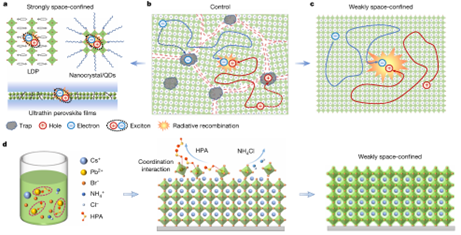In a study published in Nature, a research team led by Prof. XIAO Zhengguo from the University of Science and Technology of China (USTC) of Chinese Academy of Sciences has proposed an alternative strategy based on weakly space-confined, large-grained crystals of all-inorganic perovskite to prepare perovskite films with larger crystalline grains and higher temperature resistance. They successfully increased the perovskite light-emitting diodes (PeLEDs) brightness to over 1.16 million nits and extended its lifespan to more than 180,000 hours.

Schematics and carrier recombination kinetics of different perovskites. (Image by XIAO et al.)
Perovskite shows broad application prospects in solar cells, light-emitting diodes (LEDs), and detectors. with its high luminescent efficiency and low cost. Given that electrons and holes in traditional perovskite materials are difficult to effectively collide and emit light, researchers often use the strongly-space confined method to improve luminescence efficiency. While the previous method is difficult for LEDs to achieve high brightness and have a short lifespan, making it challenging to be applied in our life. Hence, how to enhance the brightness of LEDs and extend their lifespan has become a top priority in this field of research.
To address the issue, XIAO’s team put forward a brand-new strategy on the basis of weakly space-confined technique. Firstly, they added specific compounds, hypophosphorous acid and ammonium chloride, to the perovskite material.
Then, through a high-temperature annealing process, they prepared a new type of perovskite thin film with larger crystalline grains and fewer defects.
On the one hand, the annealing process suppressed non-radiative recombination (i.e., the process where energy was lost without producing light) and significantly attenuated ion migration.
The new type of film, on the other hand, avoided the defect problems brought by the small crystals when employing traditional methods, greatly improving the stability and brightness of LEDs.
For example, in terms of efficiency, the luminous efficiency of the new PeLEDs exceeded 22%, which was already on par with the luminous efficiency of commercial display products.
Not only that, compared with the mainstream commercial LED screens currently on the market, the new perovskite LEDs had a limit brightness of 1.16 million nits, far exceeding the highest brightness of display screens that was usually within several thousand nits.
Besides, it was theoretically able to be used for more than 180,000 hours at a normal brightness of 100 nits, which had already met the standards of commercialized LED products.
The novel method by XIAO’s team has not only overcome the technical bottlenecks in efficiency and stability of PeLEDs, but also holds great potential for widespread application in high-end display screens, ultra-high brightness lighting, and other fields in the future, propelling LED technology into a new era.
Paper link: https://www.nature.com/articles/s41586-025-09137-1
(Written by HUANG Rui, USTC News Center)